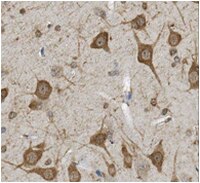Functional K(v)10.1 channels localize to the inner nuclear membrane.
Chen, Ye, et al.
PLoS ONE, 6: e19257 (2011)
2011
概要を表示する
Ectopically expressed human K(V)10.1 channels are relevant players in tumor biology. However, their function as ion channels at the plasma membrane does not totally explain their crucial role in tumors. Both in native and heterologous systems, it has been observed that a majority of K(V)10.1 channels remain at intracellular locations. In this study we investigated the localization and possible roles of perinuclear K(V)10.1. We show that K(V)10.1 is expressed at the inner nuclear membrane in both human and rat models; it co-purifies with established inner nuclear membrane markers, shows resistance to detergent extraction and restricted mobility, all of them typical features of proteins at the inner nuclear membrane. K(V)10.1 channels at the inner nuclear membrane are not all transported directly from the ER but rather have been exposed to the extracellular milieu. Patch clamp experiments on nuclei devoid of external nuclear membrane reveal the existence of channel activity compatible with K(V)10.1. We hypothesize that K(V)10.1 channels at the nuclear envelope might participate in the homeostasis of nuclear K(+), or indirectly interact with heterochromatin, both factors known to affect gene expression. | 21559285
 |
The potassium channel Ether à go-go is a novel prognostic factor with functional relevance in acute myeloid leukemia.
Agarwal, Jasmin R, et al.
Mol. Cancer, 9: 18 (2010)
2010
概要を表示する
The voltage-gated potassium channel hEag1 (KV10.1) has been related to cancer biology. The physiological expression of the human channel is restricted to the brain but it is frequently and abundantly expressed in many solid tumors, thereby making it a promising target for a specific diagnosis and therapy. Because chronic lymphatic leukemia has been described not to express hEag1, it has been assumed that the channel is not expressed in hematopoietic neoplasms in general. | 20105281
 |
Monoclonal antibody blockade of the human Eag1 potassium channel function exerts antitumor activity.
Gómez-Varela, David, et al.
Cancer Res., 67: 7343-9 (2007)
2007
概要を表示する
The potassium channel ether à go-go has been directly linked to cellular proliferation and transformation, although its physiologic role(s) are as of yet unknown. The specific blockade of human Eag1 (hEag1) may not only allow the dissection of the role of the channel in distinct physiologic processes, but because of the implication of hEag1 in tumor biology, it may also offer an opportunity for the treatment of cancer. However, members of the potassium channel superfamily are structurally very similar to one another, and it has been notoriously difficult to obtain specific blockers for any given channel. Here, we describe and validate the first rational design of a monoclonal antibody that selectively inhibits a potassium current in intact cells. Specifically blocking hEag1 function using this antibody inhibits tumor cell growth both in vitro and in vivo. Our data provide a proof of concept that enables the generation of functional antagonistic monoclonal antibodies against ion channels with therapeutic potential. The particular antibody described here, as well as the technique developed to make additional functional antibodies to Eag1, makes it possible to evaluate the potential of the channel as a target for cancer therapy. | 17671204
 |











